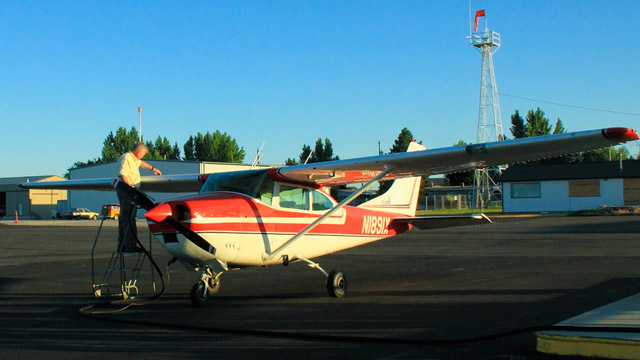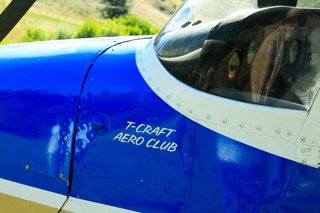
Controlling fuel costs is an issue everyone in general aviation is constantly facing, particularly flying clubs. The T-Craft Aero Club in Nampa, Idaho, has found a way to both save money and stabilize hourly rates by purchasing their fuel by the tanker load. They also use unconventional methods to market the club and recruit new members. Read our Q&A with Club President Ben Brandt to learn about how your club might be able to do the same thing.
Factsheet
| Name | T-Craft Aero Club |
| Location | Nampa Municipal Airport (KMAN), Nampa, ID |
| Website | |
| Year formed | 1975 |
| Aircraft | 1978 C-152 ($57/hr) |
| Joining fee | Class I - $500 provides access to the 152 and 172s |
| Monthly dues | $127 per month ($70 fixed costs, $57 applied to flying whether or not you fly that month) |
| Membership | 69 members (Cap of 96) |
| Scheduler | ScheduleMaster |
Your club has very affordable rates. How do you keep them so low?
Part of it is through handling our maintenance costs, but the biggest thing is purchasing our fuel in bulk. So we’re able to maintain a fairly low fuel rate.
Tell me how that works.
We worked out a deal with the FBO where we pay them to store our fuel. We pay them a flat fee for pumpage. We pay all the up front costs for the fuel, and when we get down to 1,000 gallons or less, the FBO will allow us to purchase an entire truckload of fuel. So they don’t have any risk in the fuel, we pay for all the fuel up front, and then just write the FBO a check for a per gallon storage and flowage amount.
Do you have your own fuel farm?
We use the FBOs fuel farm, that’s why we pay them the fees. Our fuel is comingled with the FBOs fuel.
How do you track the club’s fuel usage since it’s comingled with the FBO’s fuel?
We start with an account of 8,500 gallons or whatever it happens to be exactly. We’re paying the flowage on it, so each gallon that we pump has a price associated with that flowage fee. So we get a receipt that is actually much less than what the price would be. If we’re paying $0.35 per gallon for flowage—which is not what we’re paying, but let’s say that’s what we’re paying—and we pumped 10 gallons it would show $3.50 of fuel. Each aircraft has its own gas card and we run that through the FBO so we have gallons per aircraft tracked through their accounting system.
 What are your average fuel costs per gallon?
What are your average fuel costs per gallon?
I can’t give you the exact per gallon fuel cost. I would just say it’s a substantial savings.
Are there other benefits?
By working with the FBO and paying them handling costs, it helps us do two things. It helps save on the cost of fuel and it also gives us consistent fuel costs. The fuel costs aren’t bouncing around, we’ll go through 13,000-14,000 gallons of fuel a year. We’ll basically set our rates, and there’s no fear that we’re going to start going in the hole if the fuel prices go up all of a sudden. We can ride through the high spots.
How often do you buy a tanker load of fuel?
On average about twice a year. If we’ve just bought 8,500 gallons, they won’t let us just buy again when we’ve used 2,000 or 3,000 gallons based on the markets. We have to get it down to 1,000 before we purchase again, so that makes it a little bit difficult to time the market, but it still allows us to not have our prices fluctuate. It’s one thing to pay a little bit more for fuel sometimes, it’s another thing to have your hourly rates all over the place all the time.
Was it difficult to work with the FBO to get them to allow you to purchase a whole truck?
Not initially. In the last year they seem to be less happy with that arrangement than they were in the beginning. So we had to work through that with them.
How long have you had this agreement?
This will be, we’re working on our third year.
Any suggestions for other clubs that are interested in doing the same thing?
You need to figure out how to make it work for the FBO. I know we’ve struggled with that a little bit. We know the FBO is doing a great job for us and we really appreciate it. The airport is a true supporter of general aviation and we really appreciate the fact that they work with us on that.
We need to figure out things that we can do to help the FBO, maybe we can have some events and have people purchase fuel from them. I recommend asking what are some ways you can help them out.
Explain your monthly dues and use it or lose it fee?
Our monthly dues are $127. Our rate structure is $70 a month plus one hour of 152 time, which is $57. It’s a use it or lose it hour. So if you’re inactive, you can request inactive status, you wouldn’t pay the use it or lose it fee, but you would continue to pay the $70. I believe we have 13 inactive members.
Do you find having that use it or lose it keeps pilots flying more?
That’s hard to quantify, but for me personally it does because I don’t want to give up the $57. My experience, those that I talked to, I see guys flying on the 25th trying to get their hour in. So I would say that with the typical pilot it does help keep them current.
You recently had a booth at the Idaho Sportsman Show to recruit new members. Tell me about that.
Saturday was really well attended. I would guess it’s somewhere in the neighborhood of 15,000 people saw the booth.
To keep track of how many people we got through the booth, we did a drawing for a free discovery flight and I believe we had a 105 folks sign up for that drawing. And there were a number of folks that were pilots and interested in what we were doing that weren’t interested in the free discovery flight. I would say we reached another half dozen potential club members, guys who aren’t flying, and would like to get back to that.
Of that 105, a lot of them are people just signing for anything free at the show, so 20 or 30 of those might not be quality contacts. But I would say 60 to 70 are decent contacts, and hopefully there are 15 or 20 real quality contacts.
We had a handful of younger folks. We had kids, 14, 15-years-old with their parents asking when can my son start lessons, what are the regulations for these younger kids flying? That’s helpful, as you know the pilot population is getting older every year.